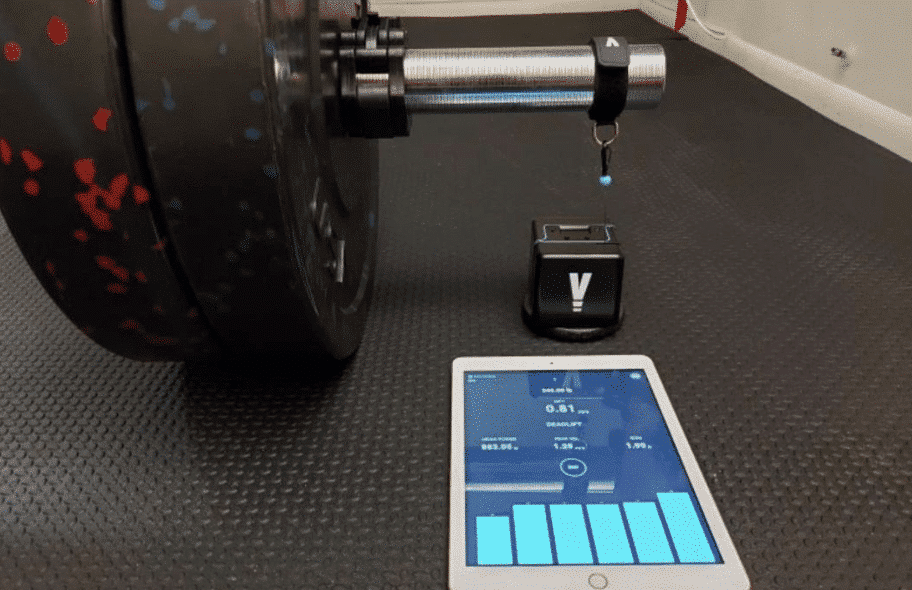3 de October de 2023
Sport tech and science Velocity Based Training
Preventing Injuries & Recovering Athletes With VBT
Bar Speed Track Devices Are The Best Option To Reduce And Recover From Injuries

Strength training in team sports has a significant impact on overall performance improvement as well as on minimizing the risk of injuries and the return to training and competition after an injury (Lauersen et al., 2014; Maestroni et al., 2020). The problem is that technology, or rather, the application of technology, hasn’t kept pace with the discoveries regarding the potential improvements from various devices in strength training programming. A greater ability to prescribe individual and precise sessions is the foundation for better adaptations, but also for something we sometimes forget: injury prevention and recovery.
Coaches, physiotherapists, and other professionals involved in strength and conditioning can do more precise work if they have objective information at their disposal to analyze if they are achieving the desired results with the program and if the generated fatigue falls within appropriate ranges. The traditional method of one-repetition maximum (1RM) is still predominantly used in strength training facilities today. While it has proven effective in the past, it has become obsolete with the advent of velocity-based training (VBT) (Balsalobre-Fernández & Torres-Ronda, 2021). Despite having ample scientific evidence, VBT is still largely unknown to most athletes and coaches.
VBT represents a less invasive and more optimal method for prescribing resistance training based on the execution speed of each repetition. This is a key element in most sports disciplines, either due to sport-specific requirements (e.g., running, accelerating/decelerating, jumping, throwing, kicking) or as an indicator of intensity (neuromuscular demands, fatigue, recovery status, etc.). VBT may seem relatively recent, but there are reports of German weightlifters using linear transducers in the 1970s (Richter, 1973). Since then, research on the benefits of VBT and how to use it to prescribe and monitor strength training has been steadily increasing, with more and more studies being conducted (Dorrell et al., 2020; González-Badillo & Sánchez-Medina, 2010; Pareja-Blanco et al., 2020). Being able to objectively monitor strength sessions, adjust goals individually, or provide daily real-time feedback is crucial, especially when working with elite athletes (Balsalobre-Fernández & Torres-Ronda, 2021).
As strength and conditioning coaches, we have two fundamental roles: improving our athlete’s performance and preventing injuries. Both tasks involve controlling training variables on an individual and daily basis, which is practically impossible without sufficient technology or technical equipment. Below, we will discuss how the use of VBT helps reduce the number of injuries and also supports athletes in returning to training and competition after an injury.
One Athlete, One Training. VBT is Precision.

When I first started learning about training periodization, I was constantly searching for ways to optimize every minute of training. Should I go with linear or undulating periodization? How much volume and intensity should I increase between each session and week? The more I learned, the more questions arose. When I discovered VBT, it was like finding a needle in a haystack. The speed-based strength training system eliminates all the haystack and leaves only what interests us: the stimulus and fatigue.
If we can control both factors in training, we have everything we need to provide the minimum stimulus for maximum performance, which indirectly comes with lower fatigue. Lower fatigue, in turn, is associated with a lower risk of injury. The ability to control fatigue is also crucial when it comes to athlete recovery after an injury and monitoring how they gradually regain their previous strength and power values. Therefore, VBT is a tool that has changed the training paradigm (González-Badillo et al., 2022), and we can take advantage of speed measurement devices like Vitruve to improve performance, prevent injuries, and help athletes recover after an injury.
One of the many studies in the scientific literature is a clear example of the precision of VBT (Jiménez-Reyes et al., 2017). Jiménez-Reyes and colleagues compared training where all athletes trained equally, without considering their strength-speed profile or using VBT, with training where each athlete addressed their weaknesses, measured using a VBT device like Vitruve. The results left no room for doubt: when VBT was used to work precisely with each athlete, everyone improved. However, when everyone trained the same way without that specificity, some improved, some stayed the same, and some even got worse.
This article demonstrates that VBT leads to many more adaptations, among other things, due to fatigue control. We now know that if we control fatigue, we are less likely to get injured, and if we are injured, VBT helps us fine-tune each recovery session.
VBT is The Key To Injury Prevention

VBT Generates Less fatigue. Less Fatigue = Less Injuries
A recent narrative review suggests that VBT can reduce neuromuscular fatigue and provide quality training to induce neuromuscular adaptations (Włodarczyk et al., 2021). Lower energy consumption and fatigue during strength training can help you better complete your training plans and reduce the risk of overtraining and injuries (Jones et al., 2017). By training more precisely, we avoid overtraining and undertraining, both of which are enemies of injuries.
Depending on our sport, there are different times during the season when controlling fatigue is crucial. If we push too hard with intensity and fatigue, we increase the risk of overtraining injuries. If we fall short on intensity, we may see a drop in performance by training less than we should. VBT allows us to provide the maximum stimulus with minimal fatigue, which is vital at all times but even more so during critical moments in the season when we need to be at a peak level of performance and maintain it.
VBT works like a traffic light:
if the athlete is in the green, we train; if the athlete is in the red, we rest. VBT provides real-time information about the athlete’s condition. Thanks to this quickly and easily obtained information, the coach knows whether the athlete has recovered from the previous session or is still fatigued (Held et al., 2021). Something as simple as performing a vertical jump or executing a repetition as fast as possible with a specified weight will tell us whether to train or not, and even whether we can push our athlete more or less (Pareja-Blanco et al., 2019). Without a speed measurement device like Vitruve, we don’t really know the state our athletes are in for each session, nor the fatigue we are generating on that day. With these types of devices, in five minutes, we can decide to skip a training session or stop it, allowing the athlete to engage in recovery work, thus preventing a potential injury.
The operation is straightforward: ask the athlete to perform a vertical jump or move a specified load as fast as possible. The result obtained is compared to the athlete’s baseline measures. If they jump lower or move the bar slower, the traffic light turns red, indicating a need for rest or recovery. If the measurements are within the correct range because they move the load or jump as usual, we proceed with training. During that training, we adjust the loss of speed based on the desired level of fatigue (Zhang et al., 2023). This way, we can provide the athlete with an appropriate stimulus for the next hour or prescribe a higher level of fatigue, as in the preseason.
VBT improves various strength mechanisms unilaterally, and these mechanisms protect against injuries.
Strength training is essential for enhancing athletic performance, including aspects like speed, explosive strength, or maximum strength (Zhang et al., 2022). Well-trained muscles not only support our joints but also provide the best possible protection against musculotendinous injuries, such as hamstring ruptures, which are common in sports with frequent changes of direction (Beato et al., 2021).
Muscular imbalances are linked to injuries (Neme, J. 2022). VBT not only prevents injuries by making us stronger but also allows us to compare the strength of each limb individually to detect any imbalances between hands or legs. Speed measuring devices like Vitruve show us these imbalances very simply and quickly. You can simply perform exercises with one hand or one foot and compare one side of the body to the other. These imbalances may manifest as the ability to lift more or less weight with one arm or leg than the other, but VBT tells us something even more important: the speed at which that load is moved.
VBT Guides You Through Injury Recovery

Injuries are a part of sports, and although we can significantly minimize them with VBT, we will never achieve a 0% probability of injury. When an athlete gets injured, it’s time to work towards their return to competition, or “return to play” (Doege et al., 2021). This phase is vital for shortening recovery timelines and ensuring a safe return to training and competition. VBT plays a crucial role in the return-to-play protocol by allowing for precise adjustments in load and fatigue during this critical phase.
A return-to-play protocol is typically well-established in each sport. These protocols involve progressive exercises that go through different phases, leading to the final step, which is medical and competitive clearance (Oak et al., 2022). The vast majority of injuries are unilateral, meaning they occur in one leg or one arm. VBT allows us to differentiate between exercises performed with the injured side and the non-injured side. For instance, if an athlete is recovering from an ACL tear, we can observe that the injured leg is far from achieving the speed and strength values of the non-injured leg.
Gradually, the athlete will feel that they are gaining strength and speed in the injured limb, and they can also track this progress on their mobile device or tablet (Hirsch & Frost, 2021). We can set targets based on the athlete’s pre-injury speed values with a specific load, and that’s where we need to get. The athlete can also immediately see the difference between both limbs and how close or far they are from the target speed.
Therefore, VBT represents a significant increase in training precision. This results in more adaptations, individualized training with each athlete, the ability to target the desired level of fatigue in each session, the decision of whether to train or not based on the athlete’s condition, and a more accurate progression through each phase of return-to-play following an injury. VBT is an upgrade to traditional strength training that exponentially enhances the work of coaches.
References
Balsalobre-Fernández, C., & Torres-Ronda, L. (2021). The Implementation of Velocity-Based Training Paradigm for Team Sports: Framework, Technologies, Practical Recommendations and Challenges. Sports 2021, Vol. 9, Page 47, 9(4), 47. https://doi.org/10.3390/SPORTS9040047
Beato, M., Maroto-Izquierdo, S., Turner, A. N., & Bishop, C. (2021). Implementing Strength Training Strategies for Injury Prevention in Soccer: Scientific Rationale and Methodological Recommendations. International Journal of Sports Physiology and Performance, 16(3), 456–461. https://doi.org/10.1123/IJSPP.2020-0862
Doege, J., Ayres, J. M., Mackay, M. J., Tarakemeh, A., Brown, S. M., Vopat, B. G., & Mulcahey, M. K. (2021). Defining Return to Sport: A Systematic Review. Orthopaedic Journal of Sports Medicine, 9(7). https://doi.org/10.1177/23259671211009589
Dorrell, H. F., Smith, M. F., & Gee, T. I. (2020). Comparison of velocity-based and traditional percentage-based loading methods on maximal strength and power adaptations. Journal of Strength and Conditioning Research, 34(1), 46–53. https://doi.org/10.1519/JSC.0000000000003089
González-Badillo, J. J., & Sánchez-Medina, L. (2010). Movement velocity as a measure of loading intensity in resistance training. International Journal of Sports Medicine, 31(5), 347–352. https://doi.org/10.1055/S-0030-1248333/ID/22/BIB
González-Badillo, J. J., Sánchez-Medina, L., Ribas-Serna, J., & Rodríguez-Rosell, D. (2022). Toward a New Paradigm in Resistance Training by Means of Velocity Monitoring: A Critical and Challenging Narrative. Sports Medicine – Open, 8(1). https://doi.org/10.1186/S40798-022-00513-Z
Held, S., Hecksteden, A., Meyer, T., & Donath, L. (2021). Improved Strength and Recovery After Velocity-Based Training: A Randomized Controlled Trial. International Journal of Sports Physiology and Performance, 16(8), 1185–1193. https://doi.org/10.1123/IJSPP.2020-0451
Hirsch, S. M., & Frost, D. M. (2021). Considerations for Velocity-Based Training: The Instruction to Move “As Fast As Possible” Is Less Effective Than a Target Velocity. Journal of Strength and Conditioning Research, 35(Suppl 1), S89–S94. https://doi.org/10.1519/JSC.0000000000003233
Jiménez-Reyes, P., Samozino, P., Brughelli, M., & Morin, J. B. (2017). Effectiveness of an Individualized Training Based on Force-Velocity Profiling during Jumping. Frontiers in Physiology, 7(JAN). https://doi.org/10.3389/FPHYS.2016.00677
Jones, C. M., Griffiths, P. C., & Mellalieu, S. D. (2017). Training Load and Fatigue Marker Associations with Injury and Illness: A Systematic Review of Longitudinal Studies. Sports Medicine (Auckland, N.Z.), 47(5), 943–974. https://doi.org/10.1007/S40279-016-0619-5
Lauersen, J. B., Bertelsen, D. M., & Andersen, L. B. (2014). The effectiveness of exercise interventions to prevent sports injuries: a systematic review and meta-analysis of randomised controlled trials. British Journal of Sports Medicine, 48(11), 871–877. https://doi.org/10.1136/BJSPORTS-2013-092538
Maestroni, L., Read, P., Bishop, C., Papadopoulos, K., Suchomel, T. J., Comfort, P., & Turner, A. (2020). The Benefits of Strength Training on Musculoskeletal System Health: Practical Applications for Interdisciplinary Care. Sports Medicine, 50(8), 1431–1450. https://doi.org/10.1007/S40279-020-01309-5/METRICS
Neme JR. Balancing Act: Muscle Imbalance Effects on Musculoskeletal Injuries. Mo Med. 2022 May-Jun;119(3):225-228. PMID: 36035582; PMCID: PMC9324710.
Oak, S. R., Klein, B., Verma, N. N., Kerzner, B., Fortier, L. M., Chava, N. S., Reinold, M. M., & Bedi, A. (2022). Rehabilitation and Return to Play of the Athlete after an Upper Extremity Injury. Arthroscopy, Sports Medicine, and Rehabilitation, 4(1), e163–e173. https://doi.org/10.1016/J.ASMR.2021.09.033
Pareja-Blanco, F., Alcazar, J., Sánchez-Valdepeñas, J., Cornejo-Daza, P. J., Piqueras-Sanchiz, F., Mora-Vela, R., Sánchez-Moreno, M., Bachero-Mena, B., Ortega-Becerra, M., & Alegre, L. M. (2020). Velocity Loss as a Critical Variable Determining the Adaptations to Strength Training. Medicine and Science in Sports and Exercise, 52(8), 1752–1762. https://doi.org/10.1249/MSS.0000000000002295
Pareja-Blanco, F., Villalba-Fernández, A., Cornejo-Daza, P. J., Sánchez-Valdepeñas, J., & González-Badillo, J. J. (2019). Time Course of Recovery Following Resistance Exercise with Different Loading Magnitudes and Velocity Loss in the Set. Sports, 7(3). https://doi.org/10.3390/SPORTS7030059
Richter, G. (1973). Ein Trainergerät zur Objektivierung der sportarts… https://www.iat.uni-leipzig.de/datenbanken/iks/tupl/Record/1001269
Włodarczyk, M., Adamus, P., Zieliński, J., & Kantanista, A. (2021). Effects of Velocity-Based Training on Strength and Power in Elite Athletes-A Systematic Review. International Journal of Environmental Research and Public Health, 18(10). https://doi.org/10.3390/IJERPH18105257
Zhang, X., Feng, S., & Li, H. (2023). The Effect of Velocity Loss on Strength Development and Related Training Efficiency: A Dose-Response Meta-Analysis. Healthcare (Basel, Switzerland), 11(3). https://doi.org/10.3390/HEALTHCARE11030337
Zhang, X., Feng, S., Peng, R., & Li, H. (2022). The Role of Velocity-Based Training (VBT) in Enhancing Athletic Performance in Trained Individuals: A Meta-Analysis of Controlled Trials. International Journal of Environmental Research and Public Health, 19(15). https://doi.org/10.3390/IJERPH19159252/S1

